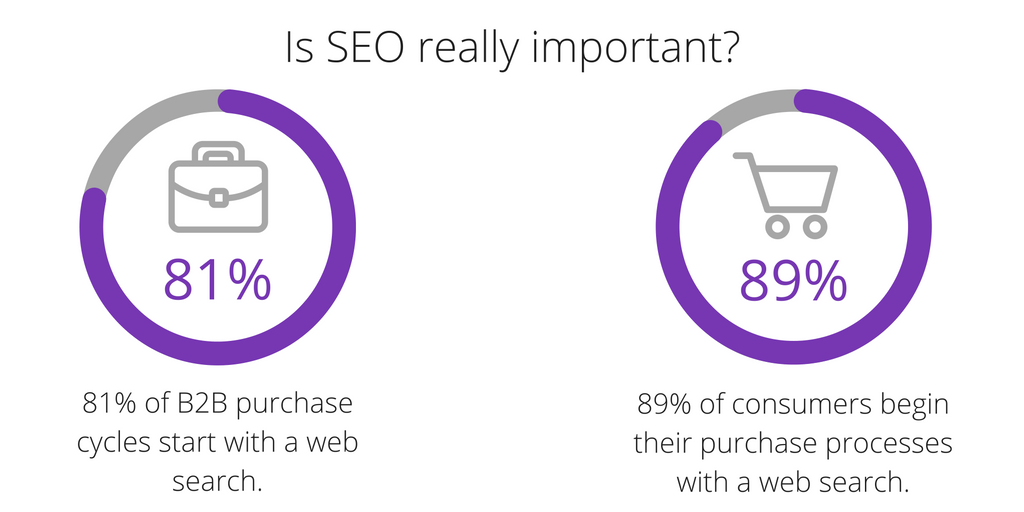SEO and Product Marketing: How to Optimize without Diluting Messaging
As a Product Marketing Manager, you have a lot on your plate—from buyer personas and product messaging, to competitive intelligence and sales enablement. You are always testing, learning, and adjusting to bring your target audience and your product together.
And that’s exactly why SEO should be your best friend.
But too many Product Marketing Managers have an outdated, siloed view of SEO. It’s true that, once upon a time, SEO was somewhat dominated by black hat tactics that tried to force keywords and links where they didn’t belong: messing up the product messaging that you spend countless hours perfecting. But that’s not how SEO works today.
Modern SEO is integrated in every aspect of marketing in order to help drive more traffic to your product or sales pages, generate and nurture more leads, and close more sales. That’s because SEO is increasingly critical for any digital marketing campaign:
- 93% of all online experiences start with a search engine. (Forrester)
- SEO is the number one lead-generating source reported by inbound marketing professionals. (Fractl)
- SEO leads have a 14.6% close rate, while outbound leads have a 1.7% close rate. (Search Engine Journal)
If you’ve avoided or disregarded SEO, it’s time to reconsider.

Great Sales Pages Start with SEO
Even the best, most compelling product messaging is worthless if no one sees it.
As the PMM, you have a better understanding of what’s right for your customers than anyone else in your company. The sales copy on your product landing pages is persuasive and effective because you know what your customers need, and you’ve perfected the art of communicating how your product satisfies those needs. But there is a lot of really good, engaging content on the web these days. Good sales copy isn’t enough anymore.
Good SEO extends your reach by combining your unique product marketing insights with an SEO team’s specialized insights about how people communicate with search engines. That means:
- SEO increases your product reach, which will lead to increased leads and conversions. If your product information appears high in search results for related queries, it allows you to get your messaging in front of an audience of information-seekers and decision-makers that have expressed a direct need for your product by making a related search query.
- SEO makes you more competitive. If your product is recommended to a prospect offline, it strengthens your brand and authority when an online search results in the same recommendation via high search ranking of your product pages. However, if an online search results in prospects finding competitor product pages in the top results, you’ll have to compete more fiercely for the sale.
- SEO attracts quality leads. Visitors from organic search have expressed an intent to purchase by performing a search for the queries you’re ranking for. This means leads that are the outcome of effective SEO may be more likely to convert than those coming from other sources.
Many product marketing managers are hesitant to fully adopt SEO because they believe it will dilute product messaging. Some were turned off by the keyword-stuffing practices of black-hat SEO—when keyword density was a ranking factor. However, keyword density does little to improve rankings today. Modern search engine algorithms are more advanced, so it is no longer necessary to fill product pages with unnatural references to search terms.
In most cases, inserting keywords into just a few important places is sufficient for ensuring your page appears for relevant queries. Even if you’re wholly unwilling to incorporate keywords on your product pages, there are many alternative ways to cater to searchers and drive organic traffic without diluting product messaging.
Incorporating SEO Into Existing Initiatives
Embedding SEO efforts into product launch and marketing campaigns doesn’t mean diluting product messaging, but it does require ensuring sales and marketing pages coordinate with what people are searching for and why they’re making the decision to buy a product. When executed effectively, SEO works in conjunction with your existing efforts to move people through the sales funnel.
SEO is most effective when paired with a full content campaign that considers the intent of prospects in each stage of the buying journey. Your SEO and content teams—if separate—need to work together to create pages that drive prospects further into the sales funnel.
- Create multiple pages and posts that cater to prospects in each stage of the sales funnel. Each piece of content can be optimized for a different keyword/user intent, and each can include a call to action that drives prospects deeper into the sales funnel.
- Create high-quality gated content—content that can only be accessed after entering contact information—that speaks to the needs and pain points that your product solves. Search-optimized gated content that ranks high in results can create an influx of leads with direct contact information.
- Don’t prioritize optimizing for non-branded keywords on sales pages if you need to ensure the integrity of your messaging (it might still happen organically, which is great). If you’re linking to your main sales pages with CTAs on keyword-optimized entry pages and posts, you can drive organic search traffic without diluting messaging.
As the product marketing manager, you know what’s best for your customers, and you have the most thorough understanding of prospect needs at the different stages of the sales funnel. For your SEO and editorial teams to execute their initiatives effectively, they’re going to need significant input from the PMM to create high-quality content funnels that transform organic search traffic into quality leads.
Successful SEO Requires Early Engagement
An elevated online presence is not just nice to have; it’s a must-have. Effective SEO can extend reach, increase leads, and drive conversions, but for SEO to be effective, it needs to be implemented as part of overall launch and marketing plans.
For the most success, bring your SEO team in early in the planning process so they have ample time to do keyword research, understand the needs and pain points of prospective buyers, and form a strategy that allows for optimized brand messaging and content. Doing so will make you more competitive, give you more authority and credibility, an increase online buzz for your brand and product.
Additional Resources:
How to Use Inbound Marketing to Close More Business
B2B Lead Generation & SEO: How to Convert Organic Traffic into Leads
The Case for B2B SEO: 4 Reasons It Cannot Be Ignored
How to Build an SEO Team for Cross-Department Results
What's Next?
Profound Strategy is on a mission to help growth-minded marketers turn SEO back into a source of predictable, reliable, scalable business results.
Start winning in organic search and turn SEO into your most efficient marketing channel. Subscribe to updates and join the 6,000+ marketing executives and founders that are changing the way they do SEO:
And dig deeper with some of our best content, such as The CMO’s Guide to Modern SEO, Technical SEO: A Decision Maker’s Guide, and A Modern Framework for SEO Work that Matters.




